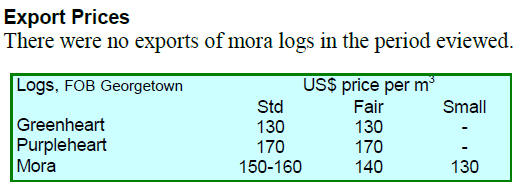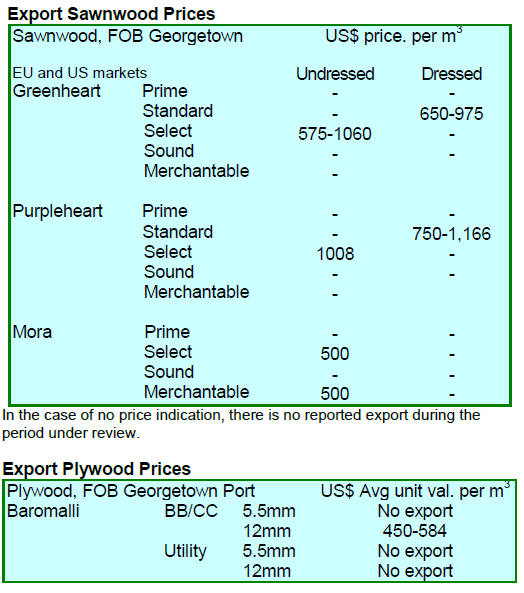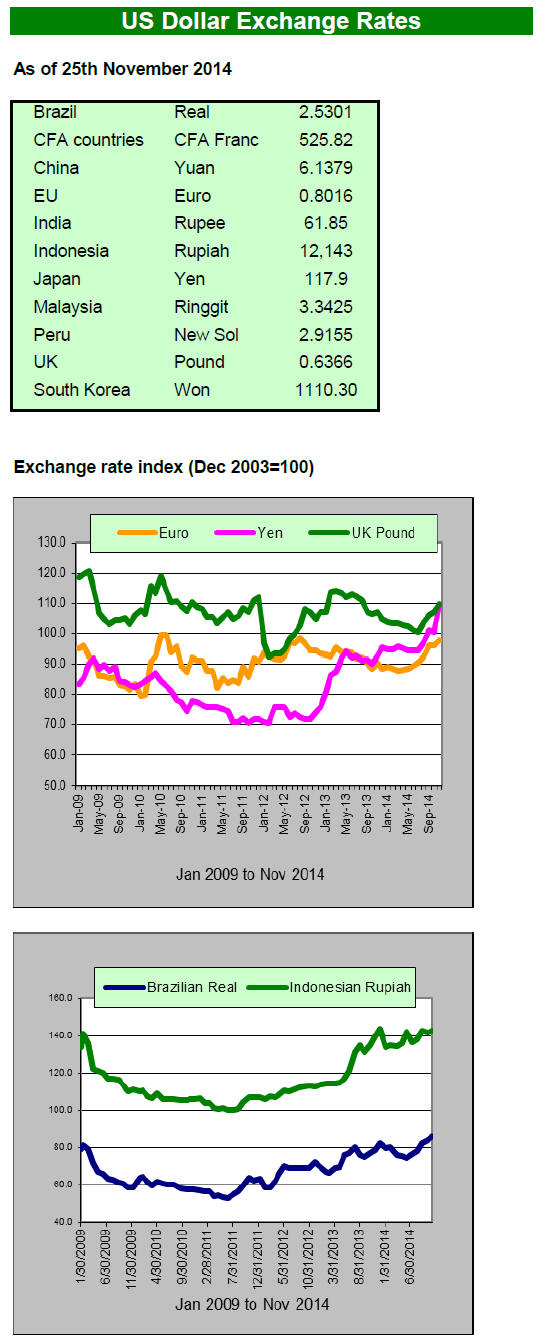2. GHANA
2015 budget statement refers to forestry
development plans
In the 2015 budget statement the Minister of Finance, Mr. Seth E.Terkper,
had the Following to say on Forestry:
The continued implementation of the new Forest and Wildlife Policy, which
will shift the focus from over-reliance on timber harvesting to conservation
of biodiversity and watershed management, will provide long term benefits to
all Ghanaians. The new policy also encourages reforestation and restoration
of degraded landscapes
Ecotourism will be promoted as part of efforts to diversify revenue
sources within the forestry sector
A national wood tracking system under the Voluntary Partnership Agreement
between the Government of Ghana and the European Union will be strengthened
as under this agreement Ghana is to put in place effective systems to verify
the legality of all timber exports and to strengthen forest governance
To improve forest protection additional resources will be provided to fund
Forestry officers as Public Prosecutors.
For more see:
http://www.mofep.gov.gh/budget-statements
The International Monetary Fund welcomed the 2015 budget which will reduce
the fiscal deficit provide for sound management of government finances.
Mr. Joël Toujas-Bernat¨¦, who led the recent IMF mission to Ghana said, ¡°The
budget includes some important measures to increase revenues, to eliminate
distortive and inefficient energy subsidies and to contain growth in Ghana¡¯s
comparatively high public wage bill.
At the same time, the budget allows for maintaining public investment above
5 percent of GDP as well as increasing social protection spending targeted
at the most vulnerable.
The mission also welcomed the government¡¯s aim to implement structural
reforms to underpin a sustained consolidation towards a fiscal deficit
objective of 3.5 percent of GDP by 2017.¡± See more at
http://www.imf.org/external/np/sec/pr/2014/pr14532.htm
EXIM Bank to boost exports
Ghana is to setup an Export-Import (EXIM) Bank with the aim of transforming
growth in Ghana's economy through expanded exports. This was specifically
mentioned in the 2015 budget statement from the Ministry of Finance.
According to the Association of Ghana Industries (AGI), the statement is
welcome news for the manufacturing and timber businesses. The Ghana cabinet
has already approved the setting up of a Presidential Committee to oversee
the establishment of the Ghana EXIM Bank.
Businesses losing because of power crisis
The recent unpredictable power supply is continually pushing the cost of
doing business and is subjecting domestic consumers to live with the
discomfort of the power outages and the effects on the prices of goods and
services.
In another development and according to the 2015 budget statement, fiscal
consolidation measures to be implemented include:
imposition of 17.5% Special Petroleum Tax
continuation of the freeze on employment and non-replacement of departing
public sector employees in overstaffed areas
strict implementation of the existing price adjustment mechanisms for
utility and fuel prices.
Analysts see this as a serious contractionary fiscal policy targeting low
growth and a reduced fiscal deficit for 2015.
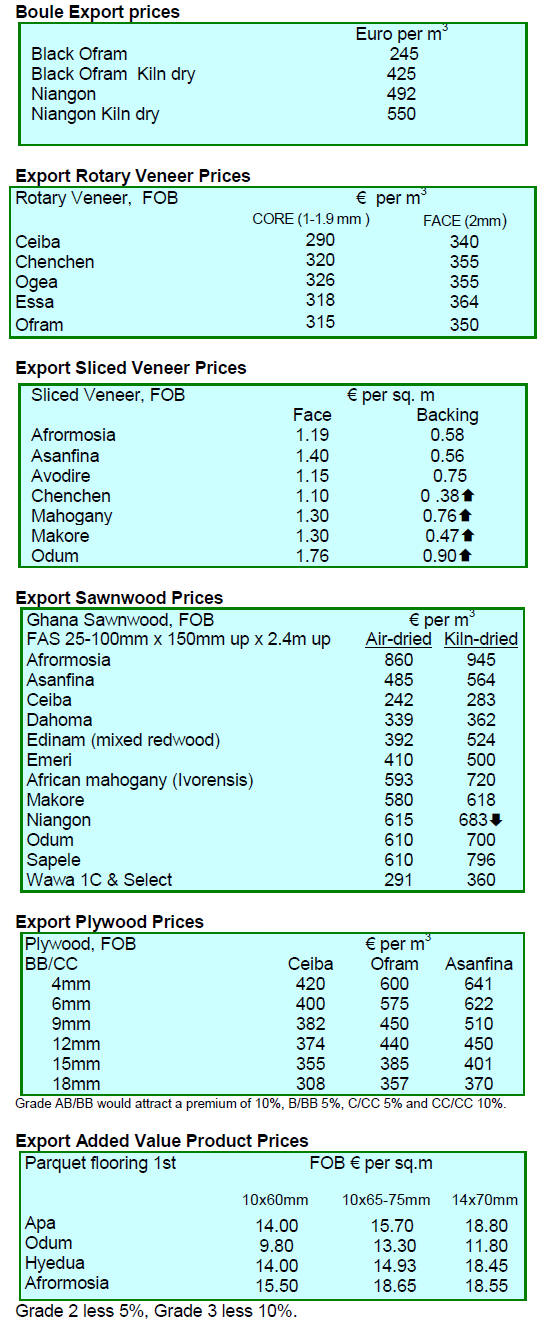
3. MALAYSIA
Sarawak companies reaffirm commitment to
good forest governance
Representatives from KTS, Rimbunan Hijau, Samling, Shin Yang, Ta Ann and WTK,
the largest timber companies in Sarawak recently signed a ¡°Corporate
Integrity Pledge¡± with the State Government as part of a move by the new
Chief Minister to promote transparency and good governance.
Malaysian Anti-Corruption Commission deputy chief commissioner, Datuk
Mustafar Ali, said ¡°the landmark document is aimed at strengthening public
and private sector commitment towards integrity and addressing corruption.
The corporate integrity pledge is a self-regulatory document. Signatories
have made a commitment to uphold anti-corruption principals.¡±
The domestic media has reported that State Cabinet members would also sign
the integrity pledge after government agencies, statutory bodies and the
private sector had done so.
Furniture largest contributor to export earnings
The Latest export statistics released by the Malaysian Timber Industry Board
showed Malaysia¡¯s exports of timber and wood products for the first eight
months this year totalled RM13.52 billion (approx. US$ 4.0 billion).
Wooden furniture was the largest contributor to export earnings at RM4.13
billion (30% of total exports), plywood was second at RM3.42 billion (25% of
the total), sawntimber third at RM1.64 billion (12%) and logs RM1.37 billion
(10%).
The breakdown of export markets reconfirmed the importance of Asian markets
as they accounted for 66% of all Malaysian timber and wood product exports.
N. American markets accounted for 15%, Europe 11%, Oceania 5% and Africa 3%.
In terms of individual countries, Japan is the most important, importing 20%
or RM 2.73 billion from Sarawak. The US accounted for 12%, India 9% and
Taiwan P.o.C and Singapore accounted for around 5% each while the UK, China,
Australia and South Korea around 4%.
Malaysian furniture manufacturers have made great strides in production but
increased competition in international markets is a growing challenge.
Philip Yap, a Malaysian furniture designer who has been successfully in
China for almost 10 years was interviewed for the Malaysian Timber Council¡¯s
TIMBER MALAYSIA and asked, ¡®where do you see Malaysian furniture going in
terms of design?¡¯
In response Mr. Yap said, ¡°For Malaysia, the OEM model which helped grow its
furniture industry is both a blessing and a curse. It was a blessing at the
beginning because it provided a good platform for our industry members to
sell the products globally. But this easy marketing process has placed many
Malaysian furniture manufacturers in a comfort zone, which is not conducive
for nurturing creativity.
Design must be the cornerstone of the industry¡¯s next level of success.
Without design, most Malaysian-made furniture will continue to be perceived
as a base for low-end, promotional furniture and we will forever compete on
price, against the likes of Vietnam and Indonesia.
Now, Myanmar has begun to open up and its hunger for investments, jobs and
economic progress will ensure a steady pace of catching up with its more
progressive ASEAN neighbours. It takes only a few years to train workers in
a case goods furniture production.¡±
For more see:
http://clientpreview.org/mtc/interviews/philip-yap-malaysian-furniture-designer-making-his-mark-in-china/
Plywood tops the export list in Sabah
The Statistics Department in Sabah released export figures for the first
nine months this year showing Sabah exported timber and wood products
totalling RM1,176 million (approx. US$347.9 million).
The main products exported were plywood (60% of total exports), sawnwood
(25% of total), veneer (6.5%), laminated boards (5%) and mouldings (3%).
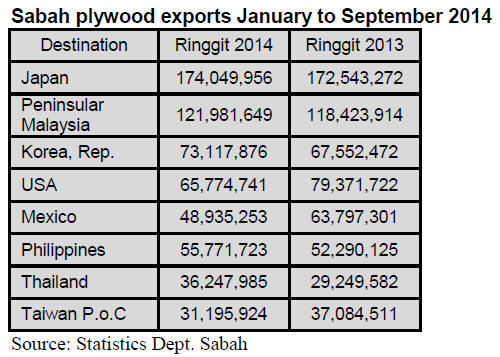
¡¡
Logging slowed by rain but log prices have not
risen
Industry analysts are surprised that log prices have not risen despite a
fall in log stocks due to the usually year-end wet season. At present
trading volumes are being maintained so log stocks are falling.
Log traders report the following FOB export prices:
Meranti SQ US$ 260 ¨C 285 per cu.m
Kapur SQ US$ 355 ¨C 375 per cu.m
Keruing SQ US$ 350 ¨C 370 per cu.m
Selangan Batu Regular US$ 475 ¨C 495 per cu,m
4. INDONESIA
More on revoking certification
requirements
The government is considering exempting timber-processing industries,
including furniture makers, from the requirement to secure legality
certification, provided domestic timber is the raw material used.
The Secretary General in the Ministry of Trade, Gunaryo, said small and
medium enterprises that use domestic timber and it should be the suppliers¡¯
duty to ensure the timber being sold satisfies the existing certification
system. Gunaryo reiterated that certification should only be mandatory for
timber producers and suppliers.
Australian guidelines for Indonesian timber imports
The Australian Government has agreed Country Specific Guidelines (CSG) to
regulate the timber trade between Indonesia and Australia. These guidelines
were endorsed by the Australian and Indonesian governments on 21 October
2014.
Guidance is provided to Australian companies on procedures to follow when
importing wood products from Indonesia.
The CSG says, ¡°This guideline has been prepared by the Australian Government
and the Government of Indonesia. It is intended to assist businesses
importing regulated timber products from Indonesia into Australia and in
understanding the regulatory framework in Indonesia in order for them to
carry out their due diligence obligations under the Illegal Logging
Prohibition Amendment Regulation 2013, which supports the Illegal Logging
Prohibition Act 2012.
In summary, to import legal timber from Indonesia Australian importers
should:
Ask whether your supplier(s) holds a SVLK Timber Legality Certificate.
If yes, make sure you are provided with a V-Legal Document for every
shipment from your supplier(s).¡±
The CSG, along with a quick reference guides, can be found at:
www.agriculture.gov.au/forestry/policies/illegal-logging/information-resources
Also see:
http://www.agriculture.gov.au/SiteCollectionDocuments/forestry/australias-forest-policies/illegal-logging/indonesia-country-specific-guideline.pdf
New Regulation on non-timber products
Environment and Forestry Minister, Siti Nurbaya, has said the government
will issue new regulations on non-timber forest products aimed increasing
the value of harvests other than wood.
She said the government is studying forestry issues one at a time and one
immediate issue to be addressed is the speedy and transparent issuing of
permits.
The minister noted Indonesia has a tremendous potential for quality non-wood
forest products such as honey, fish and bamboo.
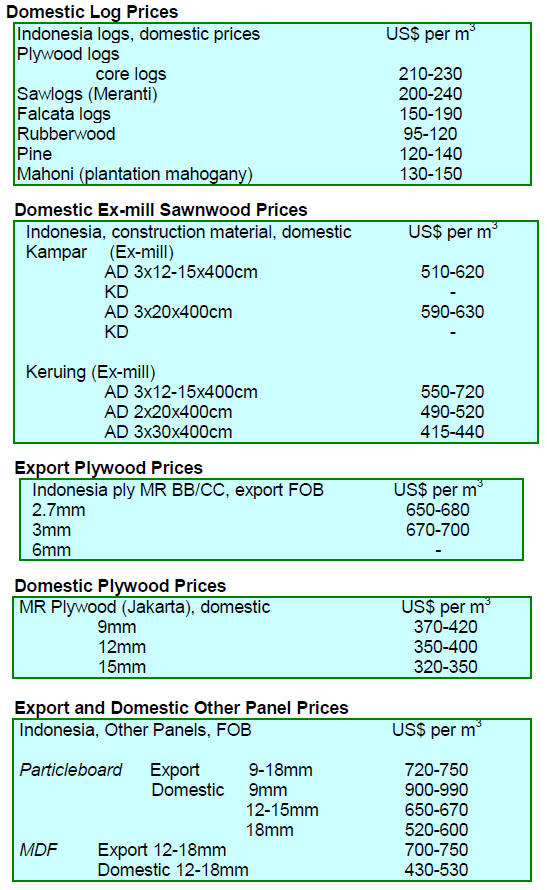
¡¡
5. MYANMAR
Privatisation of MTE
At the 22nd Annual Meeting of the Forest Products Joint Venture Corporation
(FPJVC) the Minister of Environmental Conservation and Forestry (MOECAF),
Win Tun, said the Myanma Timber Enterprise (MTE) will eventually be
privatised.
MTE was established in 1948 when the country gained independence.
A decision has already been made to lease many of the MTE mills to the
private sector and the recent announcement on privatisation is an additional
surprise. If privatisation goes ahead the question will be who will
undertake harvesting in future.
Local observers point out that the authorities will need to consider whether
MTE continues to undertake harvesting and supply the needs of the local
industry by offering logs through competitive bidding or some other
arrangement.
The government has decided that most of the State
owned enterprises will be privatised eventually. The FPJVC is a joint
venture corporation owned 45% by MTE, 10% by the Forest Department and 45%
by private shareholders.
The Corporation is listed on the Myanmar Securities Exchange Centre, a
possible forerunner of a Myanmar stock exchange.
Sale of teak and hardwoods by MTE
The Myanma Timber Enterprise (MTE) sold the following teak and hardwood logs
and teak sawnwood by special open tender during November. In the table below
the quantity of logs sold is expressed in tons (hoppus measure) while the
quantity of sawnwood is defined in cubic tons.
Sales of logs in the Tachileik area
On 18 November MTE sold 14,476 hoppus tons of teak logs and 828 hoppus tons
of hardwood logs by special tender at Tachileik (Eastern Shan State) on the
Myanmar Thailand border.
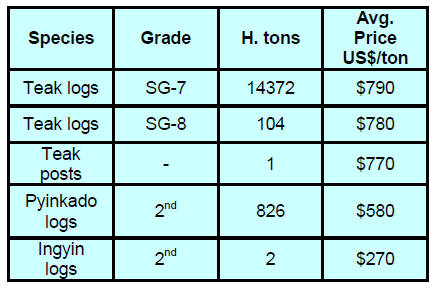
The logs are sold on condition that they are
processed within the country. The logs offered at the Tachileik sale were
extracted over the past five years.
Analysts say that the distance between Yangon and Tachileik is about 1200 km
and the distance from Mandalay to Tachileik is about 940 km which would
result in transport costs estimated at between US$4-500 per ton which means
most logs will be processed in Tachileik.
Yangon open tender sales
On 21 November 1,053 hoppus tons of teak logs were offered to buyers by MTE
and 808 tons were sold,108 tons did not attract any bids the remaining and
for 137 tons the price offered did not meet the reserve price.
In addition, hardwood logs were also offered for sale and the prices secured
are shown below.
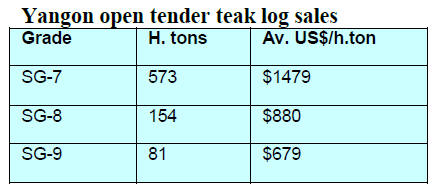
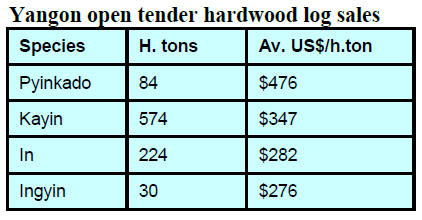
Foreign Investment in Myanmar
According to a press release from the Directorate of Investment and
Companies Administration foreign investment in Myanmar for the first 10
months of the year up until October stood at over US$50 billion, comprising
investment from 29 companies in 11 countries.
South Korea and Singapore topped the list of countries that includes
Britain, Hong Kong, Norway, China, Germany, Thailand, Brunei, Sri Lanka and
Japan. In total, companies from 37 countries have invested in Myanmar to
date.
6.
INDIA
Wood product price index drops
The Office of the Economic Adviser (OEA) to the Indian government provides
trends in the Wholesale Price Index (WPI).
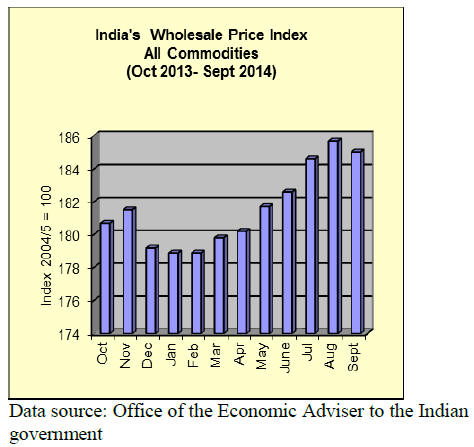
The official Wholesale Price Index for ¡®All
Commodities¡¯ (Base: 2004-05 = 100) for the month of October 2014 declined by
0.6 percent to 183.9 (provisional) from 185 for the previous month.
The annual rate of inflation, based on the monthly WP, stood at 1.77%
(provisional) for October 2014 (over September 2013) as compared to 2.38%
(provisional) for September.
For more see:
http://www.eaindustry.nic.in/cmonthly.pdf
Timber and plywood wholesale price indices
The OEA also reports Wholesale Price Indices for a variety of wood products.
The Wholesale Price Indices for Logs/timber and Plywood are shown below.
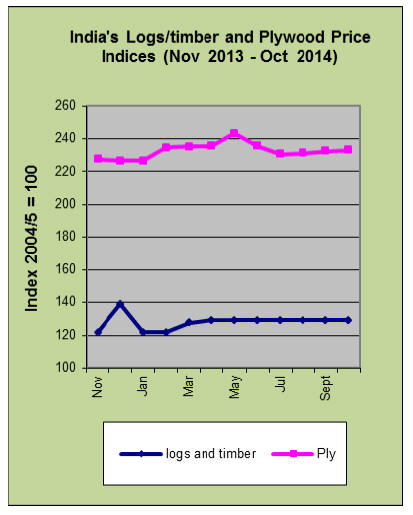
The October index for the 'Wood and Wood Products'
group rose by 0.1 percent to 186.3 (provisional) from 186.2 (provisional) in
September due mainly to higher price of veneered particleboard.
See:
http://eaindustry.nic.in/cmonthly.pdf
Revised notification on the sale of red sanders
In pursuance of authorisation given by the Convention on International Trade
in Endangered Species of Wild Fauna and Flora (CITES) and the Director
General of Foreign Trade, Government of India, the State Government of
Andhra Prades has officially notified the sale of 4,160 metric tonnes of
graded red sanders.
The timber for sale is stored in the Forest Department Depots in Kadapa,
Bhakarapet, Tirupati, Udayagiri, Kanigiri, Adurupally and Venkatagiri.
The original sale, scheduled for October this year, had to be postponed due
to court action which has now been concluded so the Director General of
Foreign Trade has extended the authority to sell by (6) months, that is up
to 30th April 2015.
Details of the court decision on the sale can be seen on the website of the
Forest Department and will be shared through e-mail with the prospective
bidders.
It is further certified in the tender notification that, as of the date of
issuance, there was no order from any Court in India restraining the
government of Andhra Pradesh from proceeding with the sale.
The government of Andhra Pradesh has announced that the red sanders wood
will be sold by e-tender-cum-e-auction conducted by MSTC Ltd. from
24.11.2014 to 01.12.2014.
The terms and conditions of the sale, along with the details of log lots put
up for sale can be seen at: http://forest.ap.nic.in , http://www.mstcecommerce.com
or http://www.mstcindia.co.in
Amended Forestry Bill may have new environment standards
A committee set up in August to review green laws and suggest amendments has
submitted its report to the Ministry of Environment.
The report recommends many changes to the current laws and recommends making
the whole process more transparent.
The panel proposed setting up a national laboratory
for air and water quality and instituting an all India Environment Service.
It is proposed that the new service would have a pool of officers to manage
central and state pollution control boards and related monitoring and
investigating bodies across the country.
Amendments to the current legislation may also be introduced by the
government in the Forest (Amendment) Bill, 2012 which has been pending in
the Rajya Sabha(Upper House of Parliament).
Prakash Javadekar, Minister of Environment and Forests said his ministry
would expedite consultations with all stakeholders to ensure that the
recommendations would enhance his ministry's efforts to "avoid undue delays
and ensure transparency in clearances and implementation of projects".
Imported plantation teak
Prices for imported plantation teak reported below are unchanged from two
weeks earlier.
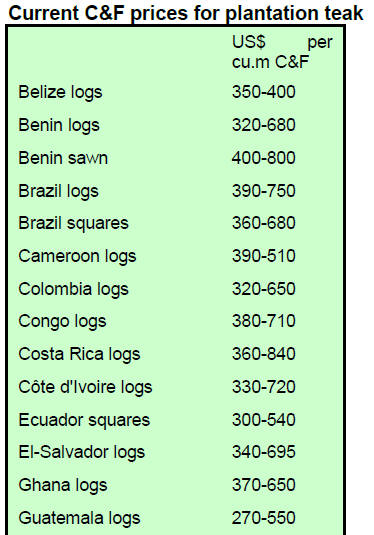
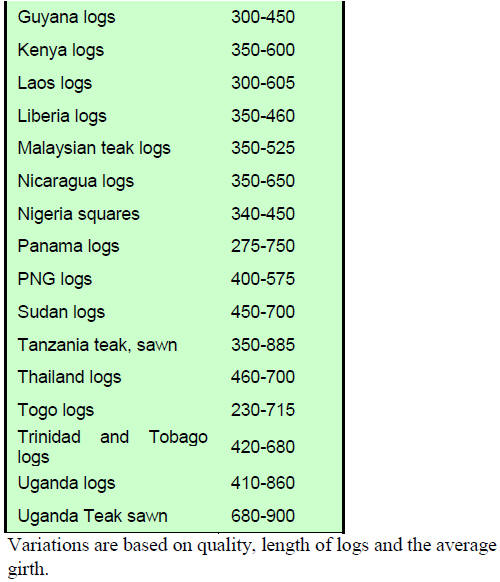
Prices for domestically milled sawnwood from
imported logs
Current prices in the domestic market for air dried sawnwood remain
unchanged.
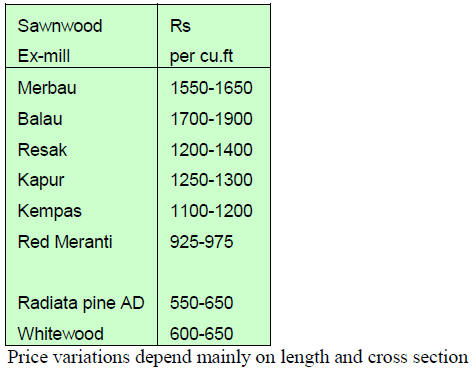
No pick-up in shipments of sawn teak from
Myanmar
Indian end-users of locally sawn Myanmar teak are still holding out against
the major price increases being proposed by sawmillers. The news from
Myanmar is that the authorities do not intend to change direction on the log
export ban despite requests from buyers for a phased approach to the ban.
The pace of shipments of teak sawnwood from mills in Myanmar to India has
not picked up as expected so some popular sizes are in short supply in the
Indian market. However, local analysts expect this situation will be
overcome as production in Myanmar increases.
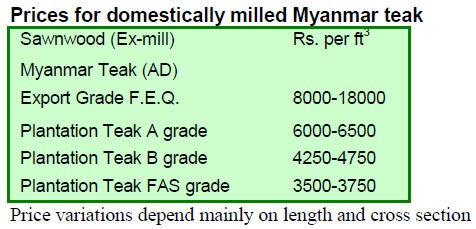
Imported 12% KD sawn wood prices per cu.ft
ex-warehouse
Demand in India for imported hardwoods remains steady and prices are
unchanged from two weeks earlier.
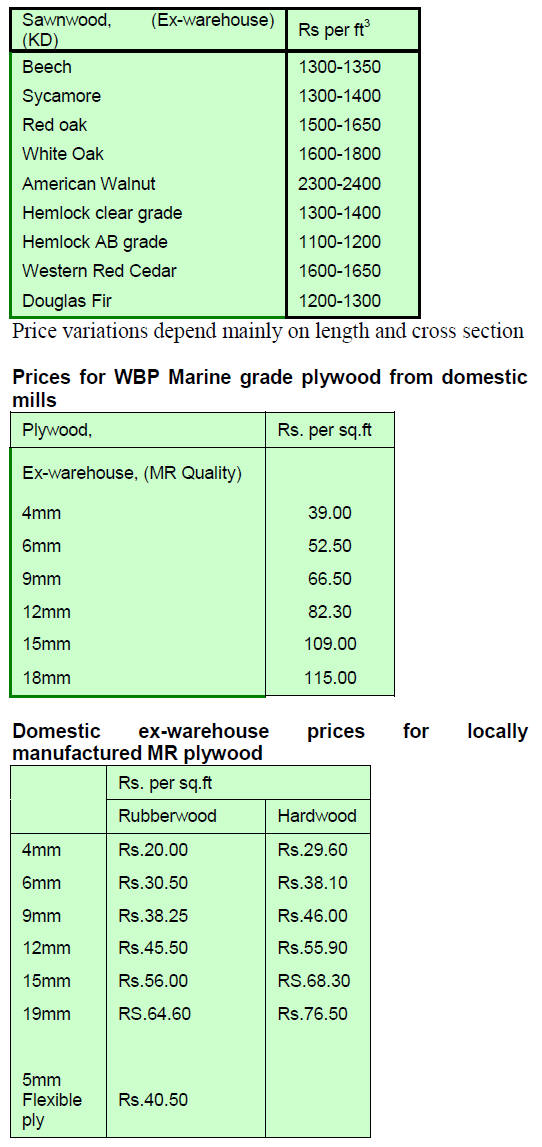
7.
BRAZIL
ABIMCI suggestions for boosting
competitiveness
The Brazilian Association of Mechanically-Processed Timber Industry (ABIMCI)
has presented specific recommendations to the Ministry of Development,
Industry and Foreign Trade (MDIC) in order to promote the development of the
timber industries in Brazil.
ABIMCI advocates the inclusion of sawnwood into the REINTEGRA regime
(Special Regime for Return of Tax Values for Exporting Companies); the
ABIMCI document submitted to MDIC shows production and export data and the
positive impact tax relief would have on maintaining competitiveness.
Also, ABIMCI is encouraging the Brazilian government to negotiate inclusion
of more Brazilian timber products within the United States Generalized
System of Preferences (GSP), which would eliminate import duties that, in
the case of pine plywood, is 8%.
Another measures suggested by ABIMCI is the need to promote greater domestic
use of timber in house building, stimulating domestic consumption of wood
products as well as tax incentives to increase the area of planted forests.
According to ABIMCI, the wood based industries accounted for 35% of Brazil's
fiscal surplus in 2012.
Economy snapshot
Brazil¡¯s Consumer Price Index (IPCA) moved up 0.42% in October after the
increase of 0.57% in September. Year on year the October 2014 figure
represented a decline. For the 12 months ending October 2014 inflation as
measured by the IPCA stood at 6.59%, marginally down year on year.
The Monetary Policy Committee (COPOM) of the Brazilian Central Bank
increased the prime interest rate (Selic) from the equivalent of 11% to
11.25% annual rate.
October exports firmly in positive territory
In October 2014, exports of all wood products (pulp and paper not included)
increased 21% in value compared to October 2013, that is from US$228.4
million to US$276.0 million.
Pine sawnwood exports increased significantly (45%) in value in October 2014
compared to October 2013, from US$15.8 million to US$22.9 million. In terms
of volume, pine sawnwood exports rose 44.5%, from 68,100 cu.m to 98,400 cu.m
over the same period.
In October tropical sawnwood exports were up 23.4% in volume, from 27,400
cu.m in October 2013 to 33,800 cu.m. and export values increased 19.0% from
US$15.8 million to US$18.8 million.
Pine plywood exports expanded close to 13% in value in October 2014 in
comparison with October 2013, from US$37.7 million to US$42.5 million but
export volumes increased by only 3.2%, from 109,100 cu.m to 112,600 cu.m.
In a similar trend, tropical plywood exports increased 4.5% in volume, from
4,400 cu.m in October 2013 to 4,600 cu.m in October 2014 (still low compared
to level of exports in the past 10 years). In terms of value, tropical
plywood export earnings remained the same at US$2.7 million.
Brazil¡¯s exports of wooden furniture increased from US$44.3 million in
October 2013 to US$50.6 million this October, a 14.2% rise.
International buyers to visit furniture industry in southern Brazil
The furniture cluster of Santa Catarina state, in southern Brazil, will host
a visit by a group of buyers from Colombia and Argentina in December 2014.
The International Business Center of Santa Catarina Industries Federation (FIESC)
sent a business mission to Colombia in October this year and the Federation
will soon host a return visit of a group of buyers to visit furniture
companies in São Bento do Sul, Santa Catarina.
The group of buyers from Argentina will also be visiting São Bento do Sul´s
solid wood furniture manufacturers and will also visit other furniture
clusters in Rio Negrinho and Mafra municipalities.
The group from the Argentines has indicated it wishes to learn about sector
training programmes as well as the administration and management models
applied to the sector.
Interzum plans feature on Brazilian furniture sector
Brazil is Germany¡¯s largest trading partner in South America according to
reports from Interzum, the largest furniture industry fair. Brazil is the
seventh largest furniture producer.
The Interzum international fair takes place every two years in Germany and
the next event will be in May 2015 and the organisers are preparing to
feature the growth in Brazil¡¯s furniture sector.
Brazilian furniture is attracting the attention of importers in Europe as it
contains a high proportion of recycled material and participation in the
2015 fair is expected to yield substantial sales.
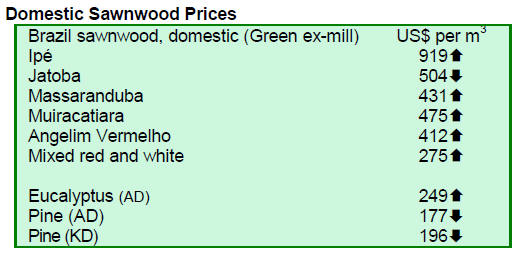
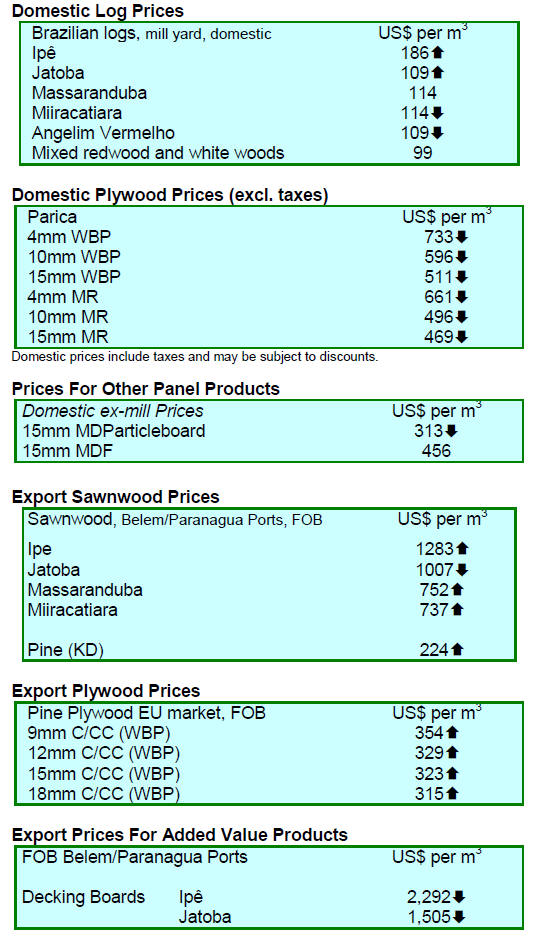
¡¡
8. PERU
Success with door exports
The Peru Exporters Association (Adex) has reported that, between January and
September, exports of wooden doors and frames were worth US $746,400 a
six-fold increase over the same period last year. Panama is the main market
for the wooden doors and frames accounting for over 90% of shipments from
Peru rose due to massive investments in both public and private construction
in Panama.
Panama¡¯s President, Juan Carlos Varela, is forging ahead with plans to
renovate the city of Columbus to address basic sanitation and housing.
Nationwide the investment in housing continues representing a great
opportunity for Peruvian exporters.
China is the main supplier of wooden doors and frames to Panama but
consumers in Panama say it is the quality of Peruvian products that set them
apart.
In the first three quarters of the year Peruvian doors and frames were also
exported to Italy the US and Chile.
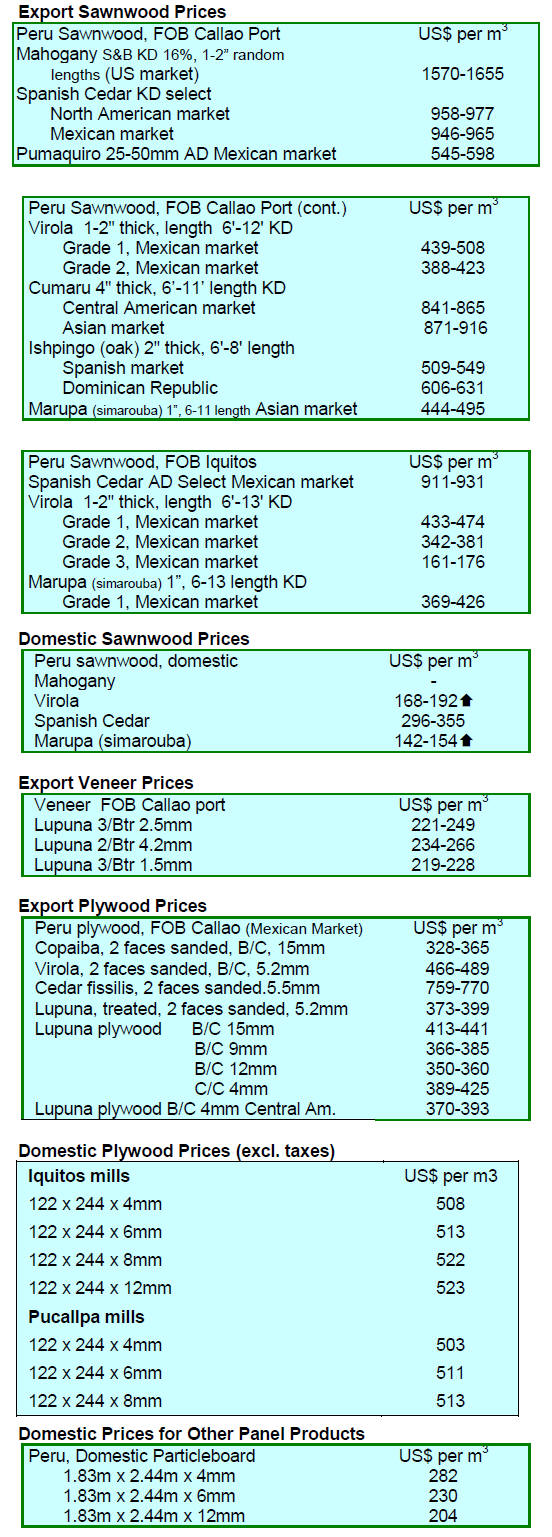
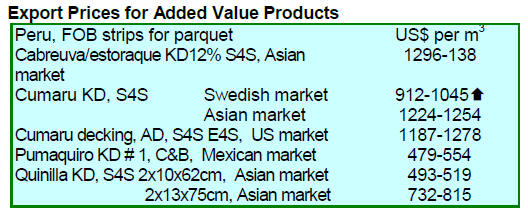
9.
GUYANA
Guyana¡¯s ¡®rosewood¡¯ attracting Asian
buyers
Guyana¡¯s export trade began very quietly at the beginning of the year and in
January there were no exports of the main commercial logs; greenheart,
purpleheart and mora.
However, at the same time wamara (Swartzia leiocalycina) logs made headway
on the export market, particularly in Asia, securing favorable prices
ranging from US$125 to US$140 per cubic metre FOB. Prices have since
increased to as much as US$200-US$220 per cubic metre FOB.
Wamara, Swartzia spp. (S. benthamiana, S. leiocalycina) is distributed in
Southern Mexico, Central America and northern South America. Besides being
called wamara, the international name often used is Guyanese rosewood.
Wamara can used for both interior and exterior furniture, but is also
commonly used in Guyana for doors, flooring, window frames, turnery, tool
handles, joinery and a variety of other uses.
Due to Guyana¡¯s selective harvesting practices a sustainable supply of this
timber species is assured. This wood species is not listed in any CITES
Appendices or on the IUCN Red List of Threatened Species.
Wamara is especially popular for Inlays, fine furniture and cabinetry,
parquet flooring, turnings, and other small specialty items. This species
already performs well within the Asian market and should do well in the
European and Middle Eastern market.
